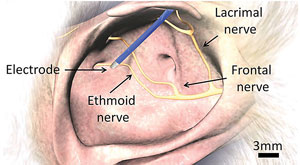Stanford University investigators recently unveiled a device that electronically stimulates tear production, hoping it will one day provide relief to patients with dry eye.
They implanted the wirelessly controlled device into rabbit eyes below the inferior lacrimal gland. It successfully increased tear generation by approximately 57%, according to the study.
 | |
| A monopolar electrode was inserted through the caudal supraorbital incisure and advanced behind the globe toward the ethmoid nerve foramen. Image: Brinton M, Chung JL, Kossler A, et al. |
First, the research group stimulated the lacrimal gland directly, which increased tear secretion by engaging efferent parasympathetic nerves, according to the study. Tearing increased proportionally with an electronic pulse of increasing strength, duration and frequency. The most effective form of stimulation was determined by measuring the tear secretion rate using the Schirmer test.
They also discovered that activating the ethmoid nerve prompted reflex tearing and offered an even more efficient way to enhance tear production.
The next phase of the research will be to evaluate the quality of the tears produced, according to the study. The device is currently being studied in clinical trials to determine maximum efficiency and safety, which the researchers hope will lead to FDA approval.
“I hope to see it on the market in the next year,” said Daniel Palanker, PhD, author of the study and professor at Stanford University, in a press release. “Meanwhile, we’re continuing research into the mechanisms of the tearing response, its enhancement and quality of the tears produced by neural stimulation.”
Dr. Palanker believes these devices could be the way of the future. “We think that these types of implants can be used in many other indications, especially in the peripheral neural system, including afferent (signaling) and efferent (controlling the organs and muscles) nerves,” says Dr. Palanker.
Brinton M, Chung JL, Kossler A, et al. Electronic enhancement of tear secretion. J Neural Eng. 2015;13(1).
